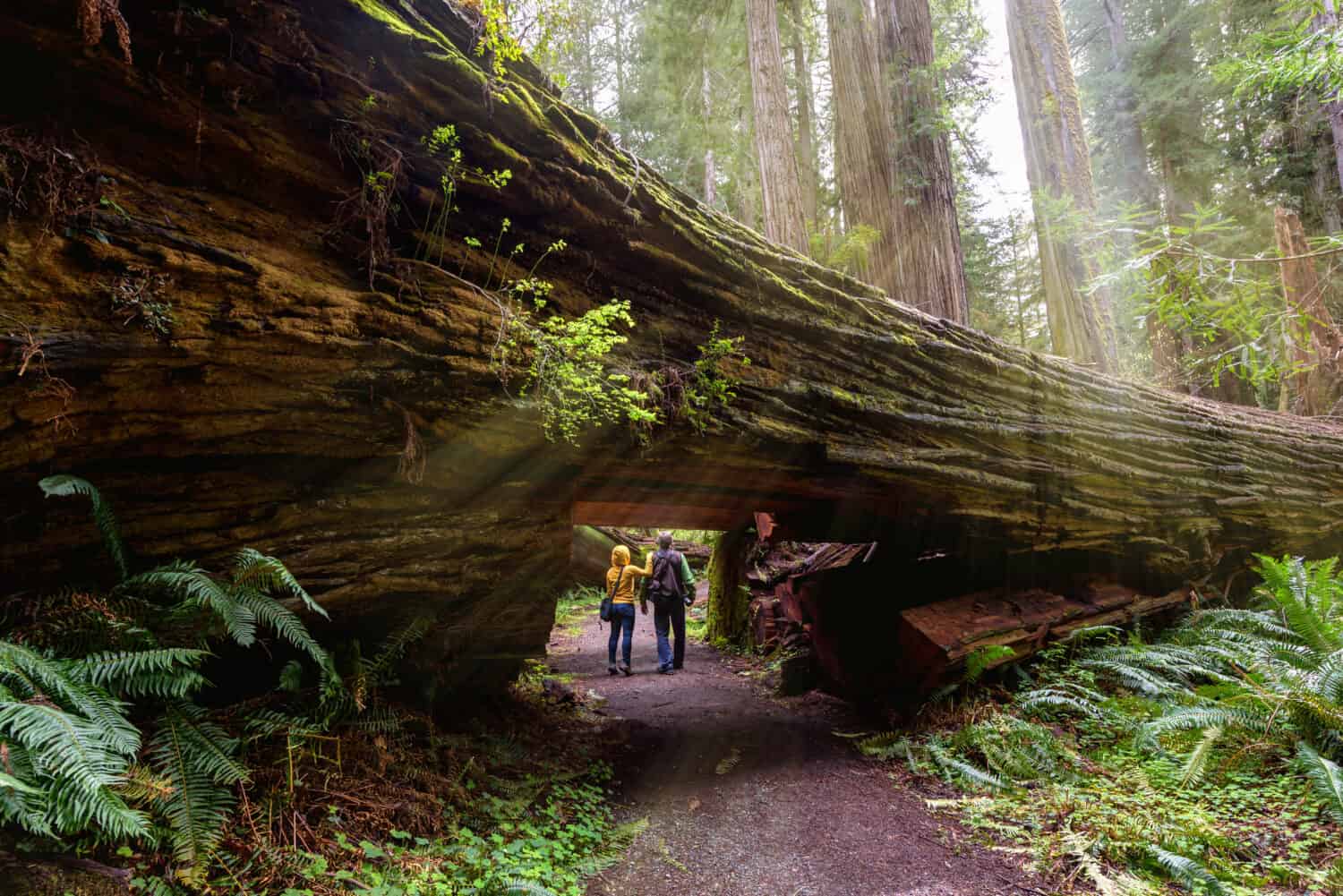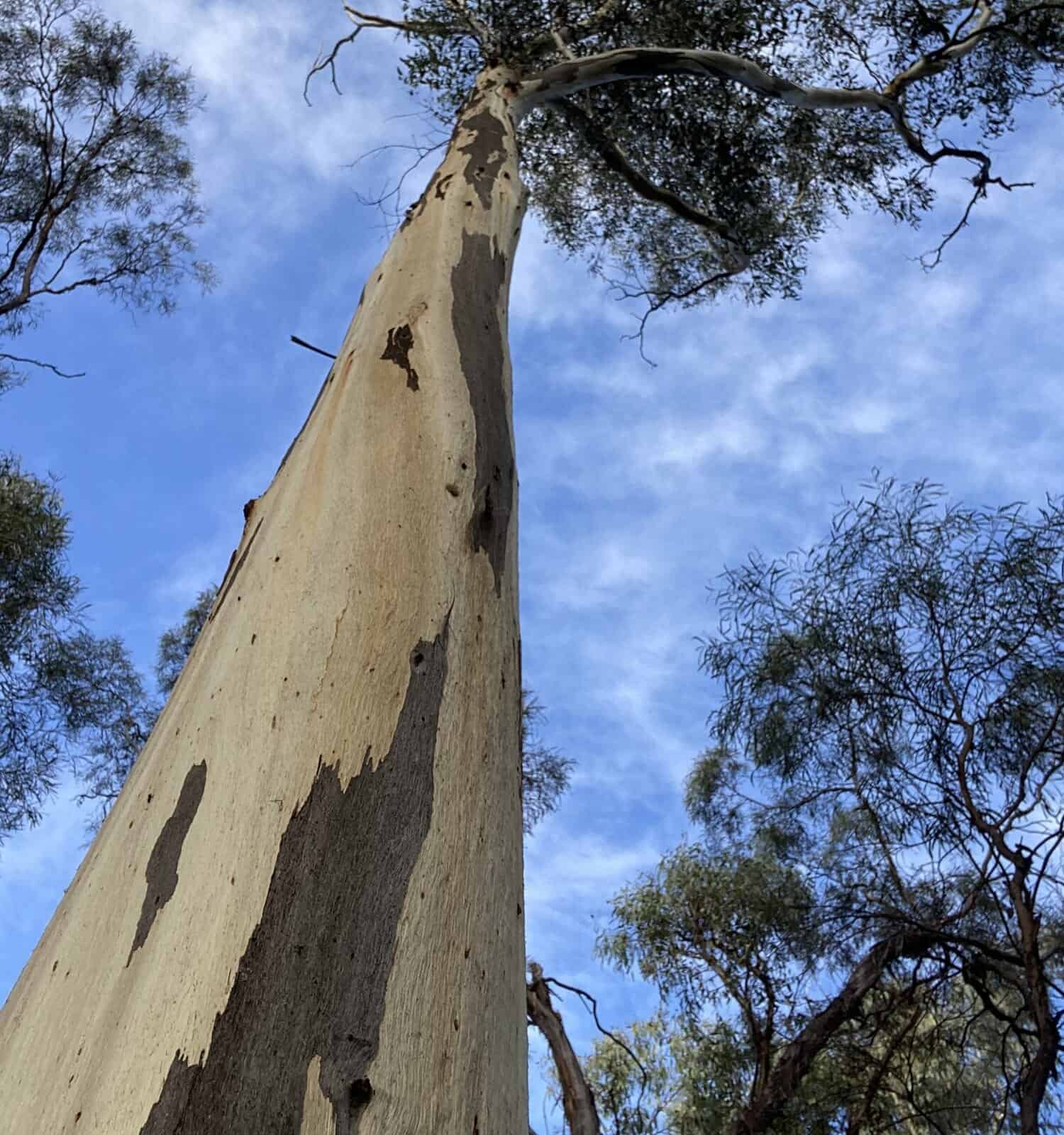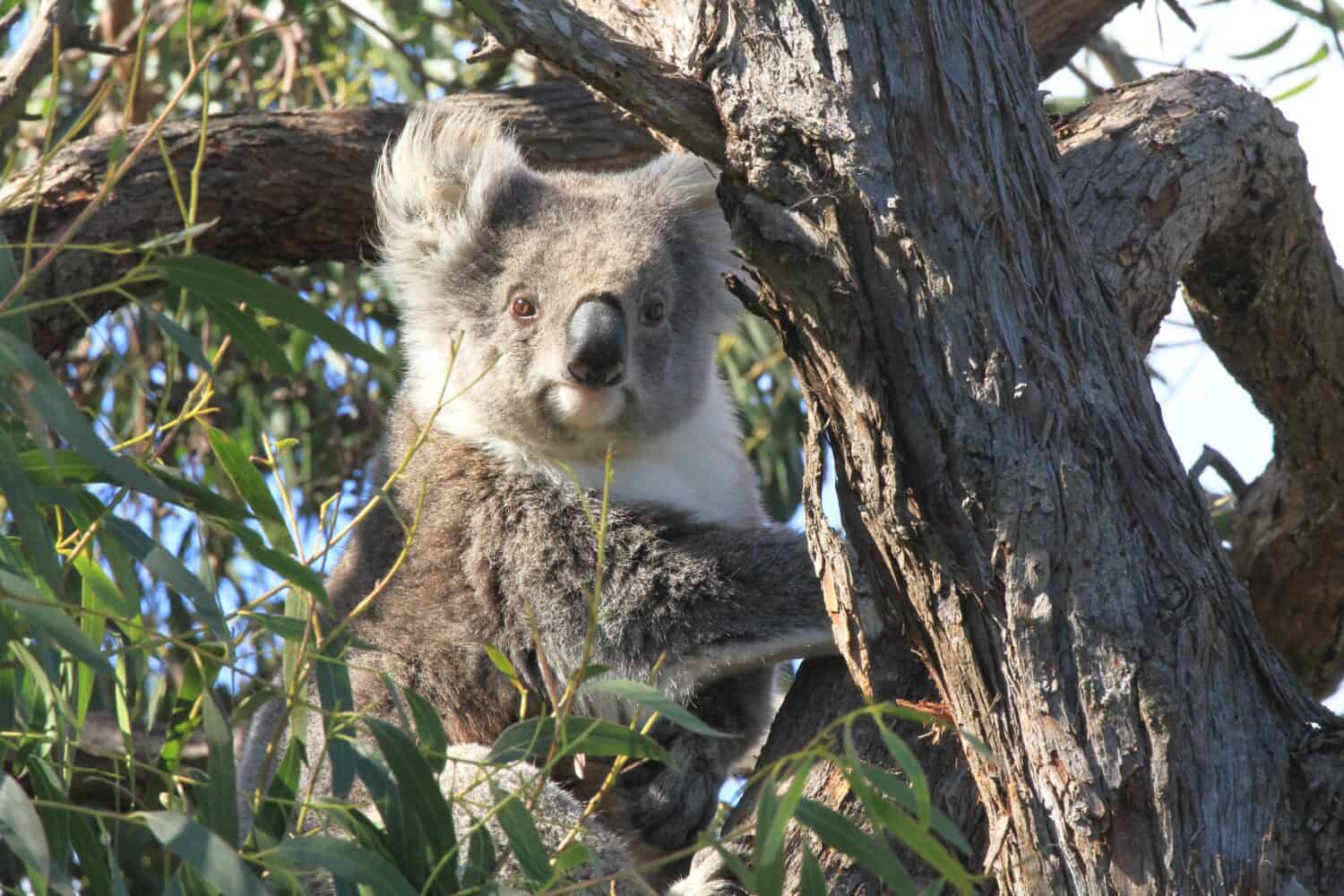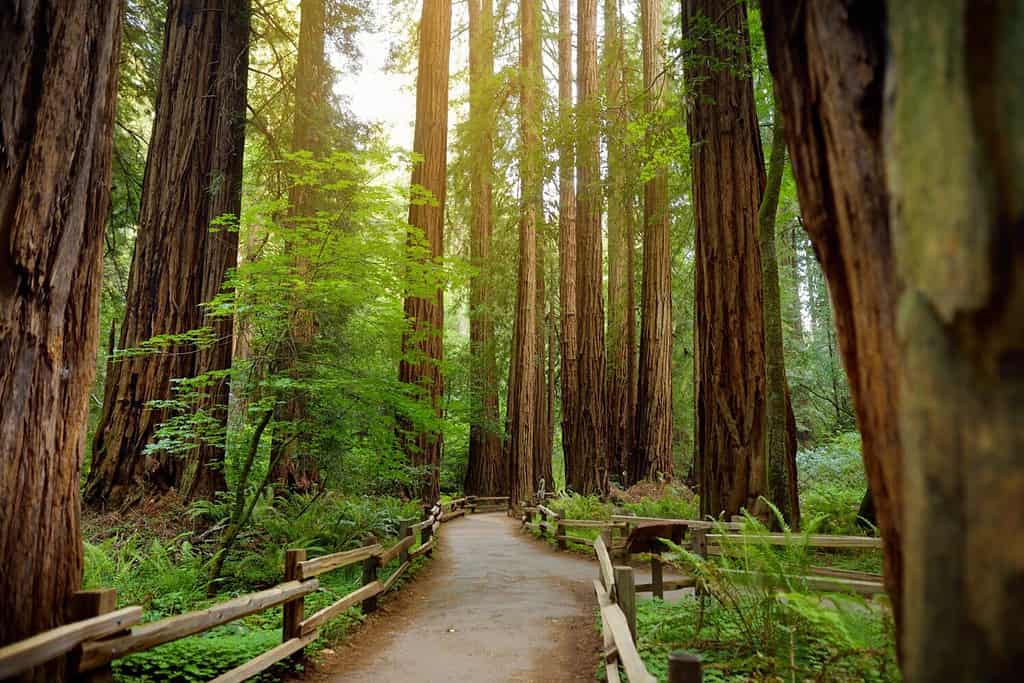Giant trees like redwoods and manna gum trees are crucial to our forest ecosystems. These huge trees store large amounts of carbon, reduce air pollution, and prevent water runoff. Vital for animal habitats as well as human ones, giant trees like manna gum trees and coast redwoods are essential. However, there are some big differences when you compare a manna gum tree versus a coast redwood.

The tallest coast redwood may be found in Redwood National Park. The giant coast redwood is nicknamed the Hyperion Tree.
©Yaya Ernst/Shutterstock.com
| Manna Gum Tree | Coast Redwood | |
|---|---|---|
| Classification | Kingdom: Plantae Clade: Tracheophytes, Angiosperms, Eudicots, Rosids Order: Myrtales Family: Myrtaceae Genus: Eucalyptus Species: Eucalyptus viminalis | Kingdom: Plantae Clade: Tracheophytes, Gymnosperms Division: Pinophyta Class: Pinopsida Order: Cupressales Family: Cupressaceae Genus: Sequoia Species: Sequoia sempervirens |
| Origin | Australia, Tasmania | Oregon, California |
| Natural Habitat | Forests | Forests |
| USDA Hardiness Zone | Zone 7 to 10 | Zone 7 to 9 |
| Conservation Status in the US | Near Threatened | Endangered |
| Size | Height: up to 300 ft (91 m) | Height: up to 379 ft (115.5 m) |
| Shape | Straight, tall trunk; wide branches with rough bark that sheds in ribbons | Straight, slender trunk; conical crown |
| Foliage | Narrow, glossy green leaves | Needle-like |
| Wood | Hardwood, not naturally insect resistant | Softwood, insect-resistant, decay-resistant |
| Uses | Wood is used in construction, furniture, flooring, and more. | Wood is used mainly for ornamental purposes in decks, fences, paneling, etc. |
The Key Differences Between Manna Gum Tree vs. Coast Redwood

New coast redwoods can grow from seeds or sprout from stumps.
©Chmee2, CC BY-SA 3.0 – License
Though both types of trees can grow to extraordinary heights, some key differences distinguish them from one another. For instance, they have different classifications, distributions, hardiness zones, and characteristics. Here are the six key differences between a manna gum tree versus a coast redwood.
1. Manna Gum Tree vs. Coast Redwood: Classification
While manna gum trees and coast redwoods are both from the Plantae kingdom and tracheophytes, that’s where the similarities end. Manna gum trees come from the genus Eucalyptus. The plants in this genus often have smooth or fibrous bark that is hard or stringy. The leaves have oil glands, and the sepals and petals combine together in a cap-like shape. Also, the fruit these types of plants produce comes in woody capsules called a “gumnut.”
Coast redwoods, however, are in the genus Sequoia, which are typified by redwood coniferous trees. The coast redwoods, or Sequoia sempervirens, are the only extant species (a species that is still in existence) in this genus.
2. Different Distribution

Manna gum trees are often utilized to control underground seepage and stabilize landslide areas because their deep roots use large volumes of groundwater.
©Kathleen Exell/Shutterstock.com
Found mainly along south-eastern Australia, manna gum trees thrive in well-watered areas from the coast to some areas of New South Wales, the southern half of Victoria, and along the Eyre Peninsula. Manna gum trees also thrive on Kangaroo Island in South Australia. Tasmania has had several tall manna gum trees as well.
Coast redwoods stretch along the Pacific coast of North America. From Monterey County, California, to the southwestern groves of Oregon, coast redwoods grow at elevations between zero to 3,000 feet above sea level. However, they are most abundantly found at elevations of 100-2,460 feet above sea level.
Moisture is crucial for these trees. Forests of coast redwoods in the mountains thrive off of the moisture that rolls in from the ocean. But, other patches of coast redwoods find sanctuary in the deep valleys or gullies where streams and fog drip regularly water them. However, you won’t find many redwoods growing near the coast as elements like ocean spray, beach sand, and wind make conditions harsh.
3. Manna Gum Tree vs. Coast Redwood: Hardiness Zone
The Hardiness Zone Map is based on the average minimum winter temperatures of the 13 divided zones. It helps define a plant’s survival needs and area requirements.
Manna gum trees are hardy to USDA Zones 7-10. They can withstand a winter of 0°F to 10°F; however, winters around 20°F to 40°F are preferred. That would explain why manna gum trees are endemic to Australia and Tasmania.
On the other hand, coast redwoods are hardy to USDA Zones 7 to 9. While they can also survive winters between 0°F and 10°F, coast redwoods don’t typically grow in USDA Zone 10.
4. Differing Sizes and Shapes

Manna gum trees make for great habitats, especially for koalas. Koalas do much of their foraging within the branches of a manna gum tree.
©TRossJones/Shutterstock.com
Growing up to 300 ft (91 m) in size, manna gum trees form a lignotuber at the base of their trunk. A lignotuber, or “bud collar,” is a woody growth at the root crown that helps support the rapid growth of the tree and protect it from storms or fires. With a straight, tall trunk and wide branches, the bark usually appears powdery white to pale brown in color. The bark sheds in long ribbons from the upper branches, giving it a pale appearance, while the bark on the trunk is dark and rough.
On the other hand, coast redwoods are among the tallest trees in the world and can grow to an average height of 200 to 325 feet (60 to 99 m). They have remarkably straight trunks and a conical crown. The branches sag horizontally off the tree.
5. Manna Gum Tree vs. Coast Redwood: Foliage
The leaves of a manna gum tree have the same shading on top and underneath the leaf. The leaves are lance-shaped, typically growing 3-9 inches long and 0.3-1.1 inches wide. The buds are oval-like with a conical or beaked operculum. The flowers are white, and the fruit of a manna gum tree is woody and shaped like a cup or capsule.
The leaves of a coast redwood are dark green with two blue-white stomatal bands below. Ranging from 0.62-1 inches in size, the leaves are narrow and flat. However, scientists have found that coast redwoods have two types of leaves. The first, the peripheral leaf, is primarily used for photosynthesis. The axial leaf, on the other hand, is used to absorb water.
The coast redwoods also produce seed cones that are oval in shape and up to an inch in length. A single coast redwood can produce 100,000 seeds annually; however, the germination rate is very low.
6. Manna Gum Tree vs. Coast Redwood: Uses

With an average lifespan of 500-700 years, coast redwoods can live to more than 2,000 years.
©MNStudio/Shutterstock.com
Although moderately hard, manna gum timber is easy to work. As a popular hardwood timber in Australia, the manna gum tree can be used for general building and flooring. Some use it in designing furniture, while other uses include paneling and joinery. Although, because the heartwood isn’t very resistant to insects like termites, manna gum tree wood is often treated.
However, different groups are passionate about protecting manna gum woodlands because the tree’s leaves are irresistible to the koalas. Manna gum leaves are, relative to other Eucalypts, high in protein, which, for foragers like koalas, are essential food sources.
Coast redwoods are considered softwoods, and often, softwood is used in building construction and for kitchen cabinets and doors. This type of wood is often available at a lower cost because softwood trees generally have a quick growth rate. Therefore, they are easier to source than hardwoods and are considered a very renewable product. This is appealing to builders and homeowners.
The natural insect resistance and decay resistance of coast redwoods, in particular, make the wood ideal for outdoor furniture and decks. They are also extremely popular for their color, so using redwood for cabinets and indoor paneling is also common. However, they require some maintenance to keep that reddish hue of the wood.
The photo featured at the top of this post is ©
Thank you for reading! Have some feedback for us? Contact the AZ Animals editorial team.






